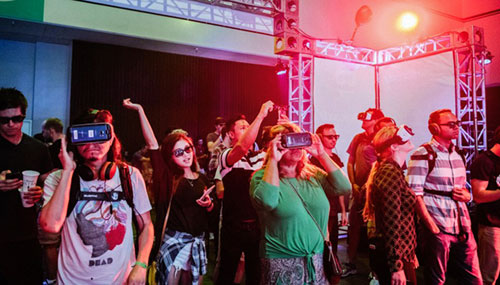Entertainment
Building a Business Model in Virtual and Augmented Reality
By Melody Yuan

Entrepreneurs explore ways to develop sustainable business models for VR and AR.
Virtual and augmented reality is oftentimes referred to as the new wild west of production and modern entertainment. With major media moguls like Sony, Facebook and Google playing in the arena, each armed with their own VR and AR platforms, how can businesses prepare to lay out a foundation for the most successful business model?
The short and vague answer is: it depends on your product or service. But, anyone could tell you that.
The long and detailed answer includes many more factors to consider and a thorough analysis of the market, including learning from peers and competitors alike.
According to Digi-Capital’s revenue forecast, VR and AR revenues could hit $120 billion by the year 2020. The revenue mix between both realities are diverse and very different, with much of VR’s revenue coming from entertainment markets such as hardware sales, games, video and theme park integrations etc. AR revenue streams seem to also include more practical applications in areas involving commerce, data, enterprise, and advertising.
The VR and AR phenomenon extends across borders and Asia is expected to take the lead in the technology’s development by 2020. While the U.S. is expected to generate higher-than-average AR/VR revenue per user, much of Asia is predicted to drive long-term revenue.
Given this information, innovative entrepreneurs are finding value in creative arenas and leveraging cross-border relationships to forge unique business models. Adam Arrigo, co-founder and CEO of The Wave VR, is trailblazing a new form of music interaction. Ryan Wang of Outpost Capital is bringing Chinese investors and U.S. companies together to create the most effective funding initiatives for projects. Nadja Muller-den Blijker, founder of SONOVR, revolutionizes positive psychology and behavioral therapy practices using VR technology.
Funding from foreign investors
“I have no doubt that China will be leading the VR/AR industry,” says Ryan Wang, partner of Outpost Capital and advisor for the Rogue Initiative, a VR and digital media content studio creating AAA cinematic interactive entertainment. “While the U.S. is enabling technologies for the industry and Silicon Valley remains the heart of R&D, China is now leading on the market side.”

"If you look at some of the largest investments in the VR/AR space from last year, most have been led by Chinese investors."
Wang asserts that China’s VR/AR adoption curve will come quickly for three reasons.
Existing public infrastructure adoption—internet cafes, shopping malls, social game rooms and theme parks are set to provide easy public access to high-end VR headsets and will serve to educate the market. Wang assumes that each of the installations, if used by 20 to 30 people a day, could potentially generate a high-end VR experience to 10,000 people per year.
China’s consumer market has consistently shown that it is much more adoptive than other markets. The success of mobile payment and e-commerce transactions point to a faster adoption rate, even if the VR/AR platform and technology are incomplete.
The Chinese government is playing an aggressive role in promoting VR and AR technology, which will further drive adoption. New policies will most likely push the public to invest in the industry.
“From a finance perspective, China is experiencing a booming primary market, while liquidity in the U.S. is shrinking,” continues Wang. “Chinese national banks are now able to participate in the VC business, which will inject more liquidity into the primary market. If we look at some of the largest investments in the VR/AR space from last year, including Magic Leap’s $850 million investment from Alibaba, most of the industry investments have been led by Chinese investors.”
In terms of soliciting from foreign investors, Wang says, “VR/AR technology exists in extremely small markets right now. Despite reports and predictions on when mass adoption will happen, the truth is we don’t know. It could be three years, it could happen after ten.” What businesses and startups need to focus on is to, “raise enough money, keep the burn rate low, and ideally make positive cash flow. For most startups, survival will be the sole focus until the industry reaches a tipping point.”
Augmenting the existing experience
"We’re not trying to overhaul the existing experience, we’re just going to enhance it."

The Wave VR is a platform that enables people to view, host and socialize in music shows worldwide, using their VR headsets. Users will now have the option to attend a concert from their living room while still enjoying real-time engagement. “We’re honestly not trying to overhaul the existing experience,” says Arrigo. “It’s like comparing apples to oranges. We’re just trying to add to the existing experience by giving music lovers the option to participate from any part of the world.” Currently with about $2.5 million in revenue and the first soft launch happening by the end of the year, the Wave VR is receiving attention from big players. The product will be available on cross-platforms for the HTC Vive, Oculus Rift, Samsung Gear, and Google Daydream.
Arrigo’s statement resonates within the AR and VR community as new players in the industry are not looking to reinvent the wheel, but to enhance it.
“VR for the healthcare industry solves two major challenges,” says Nadja Muller-den Blijker, founder of SONOVR, “it’s cheaper and has a deeper impact because it’s immersive and interactive.” While mental therapy and behavioral change practices have always been around, the addition of VR into coaching interventions are making a bigger ripple effect for meaningful change. Similar to Arrigo’s sentiments, Muller-den Blijker also believes that, “VR is not supposed to replace reality, coaches or therapists. It’s meant to provide a best practice and training ground for the real situation.”
The evolution of coaching from SONOVR.
The silver lining to establishing a business model in the VR and AR industry is that much of the initial testing and revenue model had been established with the onset of mobile apps and early analysis of consumer behavior through these tests. The challenge for new players in the industry is to identify and focus on the best revenue source, then develop and maintain a business model that can withstand rapid industry changes. So how exactly does one go about doing that?
Factors to consider when developing a business model
- Identify your target market
Muller-den Blijker understood that a low entry cost was an important factor for her target market in the healthcare industry. This helped her narrow down platforms to mobile and VR headsets that were most readily available and accessible to the mass market.
“Our business now centers around developing VR apps for behavioral coaching, and also advocates relaxation and stress management,” says Muller-den Blijker. “We identified our target market first, as mental health professionals and life hackers. We then focused our efforts on working with healthcare companies and human resource departments.”
- Trial and error
In this industry, there are no set rules. As a startup or a small business, you really have to understand the nature of your product or service and see where there is growth potential. From the HTC Vive launching a mobile VR app store to movie and television productions incorporating the technology, there is opportunity everywhere. “We ran a number of different trial runs on our platform with different subjects to make sure our therapy really worked,” says Muller-den Blijker. Companies should dip into the virtual money pot one foot at a time by testing their products on different platforms and allocating advertising dollars across various mediums before taking the plunge.
- Leveraging existing experience and networking skills
“We tested a lot of different things, and that’s helped us get to our soft launch, which will be happening by the end of the year,” says Arrigo. His own personal and team’s experience in the gaming industry, specifically for interactive games such as Rock Band, Guitar Hero and Dance Central, helped when identifying features and investment opportunities for Wave VR. In terms of revenue, Arrigo calmly notes that, “we have a lot of strong investors, but we also have a good idea of what to supplement for any additional funding.”
SONOVR has also won a number of awards, including the independently run Tedx conference called Tedx Amsterdam Women Startup Award, which helped catapult the company into connecting with more professionals within the healthcare community. Additionally, Muller-den Blijker says, “you just have to get out there and talk to people. From there, you’ll see where the biggest need is and you’ll be able to evolve your prototypes and lay down the foundation for a strong business model.”
All three entrepreneurs seem to agree that the smart thing to do is to not put all of your eggs into one basket, but to also not lose sight of the biggest revenue pull. The strategy for an effective business model is to float above all of the industry trends and changes, test out new waves of opportunity that may open new revenue streams, and to not sink too deeply into one specialty, platform, or medium.

